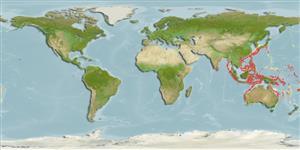>
Eupercaria/misc (Various families in series Eupercaria) >
Priacanthidae (Bigeyes or catalufas)
Etymology: Priacanthus: Greek, prion = saw + Greek, akantha = thorn (Ref. 45335).
Eponymy: John Edgar Fitch (1918–1982) was a marine biologist and ichthyologist who was Director of the US Fisheries Laboratory, San Diego. He wrote: Offshore fishes of California (1958). (Ref. 128868), visit book page.
Environment: milieu / climate zone / depth range / distribution range
Ecologia
marino demersale; distribuzione batimetrica 150 - 400 m (Ref. 5403). Deep-water
Western Pacific: southern Japan to northwestern Australia.
Size / Peso / Age
Maturity: Lm ? range ? - ? cm
Max length : 18.5 cm SL maschio/sesso non determinato; (Ref. 5403)
Spine dorsali (totale) : 10; Raggi dorsali molli (totale) : 13; Spine anali: 3; Raggi anali molli: 13 - 14. Medium-sized fish. The body is oval; dorsal fin continuous; eyes very large; mouth large and oblique, with the lower jaw projecting upwards. The head and body silvery red or pink; iris of eyes red. The fins are creamy pink; the last 4-5 soft rays of the dorsal and anal fins are clearly white. This species resembles P. macracanthus with a long and narrow preopercular spine, but has less body depth, a narrower caudal peduncle, and fainter yellowish spots on its dorsal, anal and pelvic fins.
A deeper water species trawled from relatively open bottoms at depths of 150 to over 400 m.
Life cycle and mating behavior
Maturità | Riproduzione | Deposizione | Uova | Fecundity | Larve
Starnes, W.C., 1988. Revision, phylogeny and biogeographic comments on the circumtropical marine percoid fish family Priacanthidae. Bull. Mar. Sci. 43(2):117-203. (Ref. 5403)
IUCN Red List Status (Ref. 130435: Version 2024-2)
Threat to humans
Harmless
Human uses
Pesca: di nessun interesse
Strumenti
Special reports
Download XML
Fonti Internet
Estimates based on models
Preferred temperature (Ref.
123201): 12.2 - 20.6, mean 14.8 °C (based on 141 cells).
Phylogenetic diversity index (Ref.
82804): PD
50 = 0.5002 [Uniqueness, from 0.5 = low to 2.0 = high].
Bayesian length-weight: a=0.01698 (0.00734 - 0.03932), b=2.91 (2.72 - 3.10), in cm total length, based on LWR estimates for this (Sub)family-body shape (Ref.
93245).
Trophic level (Ref.
69278): 3.9 ±0.6 se; based on size and trophs of closest relatives
Resilienza (Ref.
120179): Alto, tempo minimo di raddoppiamento della popolazione meno di 15 mesi (Preliminary K or Fecundity.).
Fishing Vulnerability (Ref.
59153): Low vulnerability (13 of 100).
